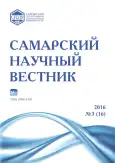Kazakhstan black soil organic substance agrogenic transformation
- Authors: Kurishbayev A.K.1, Zvyagin G.A.1, Yaroslavtseva N.V.2, Kogut B.M.2
-
Affiliations:
- S. Seifullin Kazakh Agro-Technical University
- V.V. Dokuchaev Soil Science Institute
- Issue: Vol 5, No 3 (2016)
- Pages: 35-39
- Section: 03.02.00 – General Biology
- URL: https://journals.rcsi.science/2309-4370/article/view/21930
- DOI: https://doi.org/10.17816/snv20163107
- ID: 21930
Cite item
Full Text
Abstract
Currently despite the extended study of the temporary dynamic of the cultivated soil organic substance on the global scale scientists pay much attention to the establishing the patterns of its quantitative transformation on the regional level depending on the systems of agricultural exploitation for the purpose of clarifying the worldwide estimate of humus reserve in relation to the issue of the «greenhouse effect». In this regard we have examined the modern dynamic (1990–2015) of the regular and southern black soil organic substance in the conditions of long-term stationary field experiments in the primary grain-sowing region of the Northern Kazakhstan. Based on the data from alternative time periods on the proportion of Соргand N in the upper (mainly 0–25 cm) layer of virgin and agrogenic black soil of Akmolinsk and Kostanay regions of Kazakhstan we have discovered the distinctive characteristics of changes in the content of soil organic substance. It has been demonstrated that the content of humus in the regular black soil is significantly higher than that in the southern carbonated black soil. Evaluation of transforming and inert pool of organic carbon in virgin and agrogenic variants of southern black soil has been made. It has been established that currently in the result of influence from various methods of southern black soil treatment the rate of humus percentage decrease is slowing down in comparison with that of the previous period of its agricultural exploitation, however, in practice, those methods, including the subsurface tilling, do not halt the de-humusization process. Content of humus in soil of the variants with continuous spring wheat is approaching that with continuous complete fallow. There are sufficient grounds to suggest that the reason for de-humusization of the southern black soil could reside in biochemical (mineralization), as well as physical (deflation) loss of humus. Particular danger comes from the wind erosion resulting in percentage of humus dropping even below its minimal value, i.e. due to the decrease of nearly unrecoverable inert part. In agrogenic regular black soil, during the closing period of its agricultural exploitation, there has been no humus loss detected, which is most probably related to the existence of protective anti-erosion forest belts in the studied fields area.
Full Text
##article.viewOnOriginalSite##About the authors
Akhylbek Kazhigulovich Kurishbayev
S. Seifullin Kazakh Agro-Technical University
Email: agun.rektor@gmail.com
doctor of agricultural sciences, professor, chairman of the board
Kazakhstan, AstanaGrigoriy Aleksandrovich Zvyagin
S. Seifullin Kazakh Agro-Technical University
Author for correspondence.
Email: regor1984111@rambler.ru
doctoral candidate of the Chair of Soil Science and Agricultural Chemistry
Kazakhstan, AstanaNadezhda Vasilevna Yaroslavtseva
V.V. Dokuchaev Soil Science Institute
Email: yaroslavtseva_nv@esoil.ru
candidate of agricultural sciences, researcher of the Department of Soil Biology and Biochemistry
Russian Federation, MoscowBoris Maratovich Kogut
V.V. Dokuchaev Soil Science Institute
Email: kogutb@mail.ru
doctor of agricultural sciences, head of the Department of Soil Biology and Biochemistry
Russian Federation, MoscowReferences
- Тюрин И.В. Органическое вещество почв. Л.: Сельхозгиз, 1937. 288 с.
- Кононова М.М. Проблема почвенного гумуса и современные задачи его изучения. М.: Изд-во АН СССР, 1951. 390 с.
- Чесняк Г.Я., Гаврилюк Ф.Я., Крупеников И.А., Лактионов Н.И., Шилихина И.И. Гумусовое состояние черноземов // Русский чернозем. 100 лет после Докучаева, ч. 2, гл. 4. М.: Наука, 1983. С. 186-198.
- Ярославцева Н.В. Гумусовое состояние черноземов южных карбонатных Северного Казахстана: дис. … канд. биол. наук. Алма-Ата, 1990. 145 с.
- Аринушкина Е.В. Руководство по химическому анализу почв. М.: МГУ, 1977. 489 с.
- Доспехов Б.А. Методика полевого опыта. М.: Агропромиздат, 1985. 351 с.
- Классификация и диагностика почв СССР. Почвенный ин-т им. В.В. Докучаева. М.: Колос, 1977. 224 с.
- Гришина Л.А., Орлов Д.С. Система показателей гумусного состояния почв // Проблемы почвоведения. М.: Наука, 1978. С. 43-47.
- Кёршенс М. Значение содержания гумуса для плодородия почв и круговорота азота. Посвящается 100-летию со дня рождения профессора, академика И.В. Тюрина // Почвоведение. 1992. № 10. С. 122-131.
- Когут Б.М. Оценка содержания гумуса в пахотных почвах России // Почвоведение. 2012. № 9. С. 944-952.
- Масютенко Н.П., Когут Б.М., Татошин И.Ф. Закономерности влияния обработок почвы на содержание, состав и природу гумусовых веществ черноземов // Прогноз развития эрозионных процессов и устойчивость агроландшафтов к воздействию естественных и антропогенных факторов. Курск, 1990. С. 86-103.
- Когут Б.М., Травникова Л.С., Титова Н.А., Куваева Ю.В., Ярославцева Н.В. Влияние длительного применения удобрений на содержание органического вещества в легких и илистых фракциях черноземов // Агрохимия. 1998. № 5. С. 13-20.
- Когут Б.М. Оценка уровней эродированности черноземов по относительной степени их гумусированности // Бюллетень Почвенного ин-та им. В.В. Докучаева. 2015. № 78. С. 59-69.
- Герасимов И.П., Чичагова О.А. Некоторые вопросы радиоуглеродного датирования почвенного гумуса // Почвоведение. 1971. № 10. С. 3-11.
- Чичагова О.А., Черкинский А.Е. Проблема радиоуглеродного датирования почв // Почвоведение. 1985. № 11. С. 63-75.
Supplementary files







